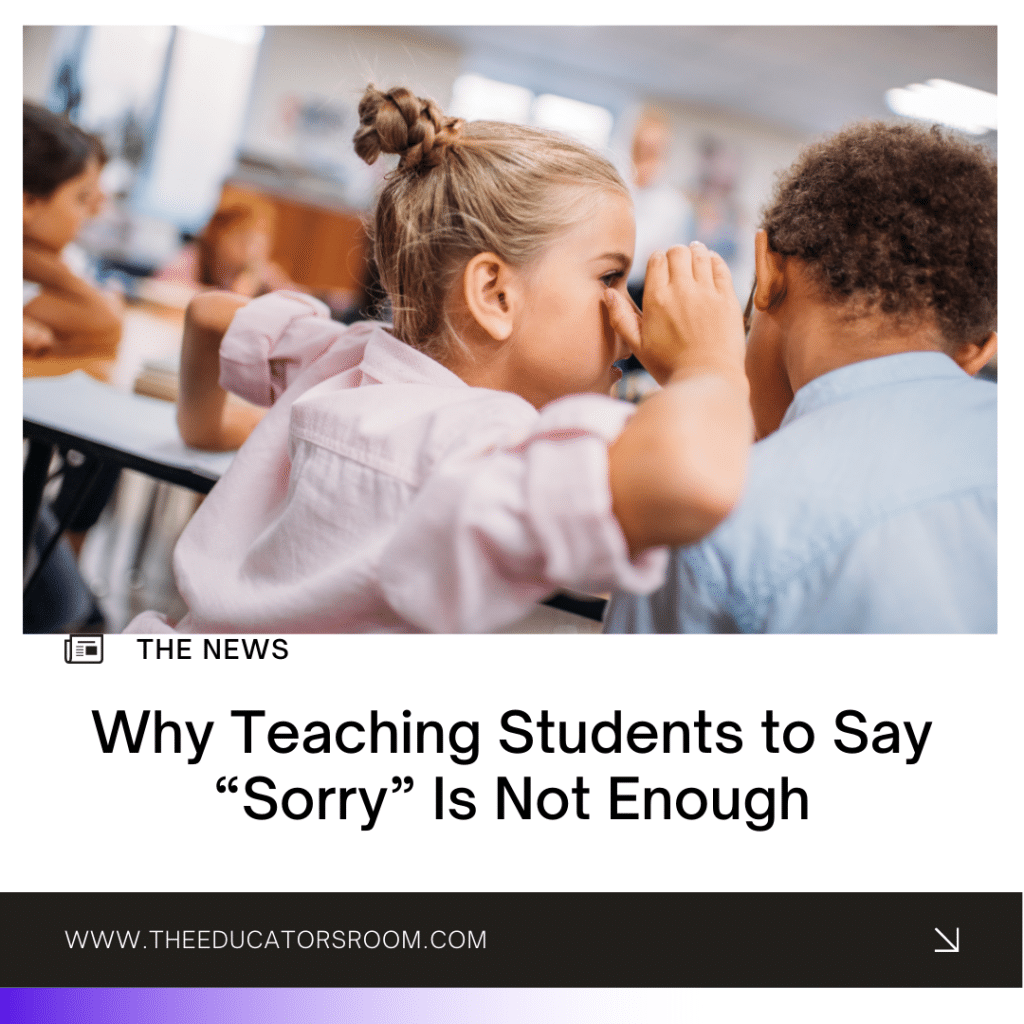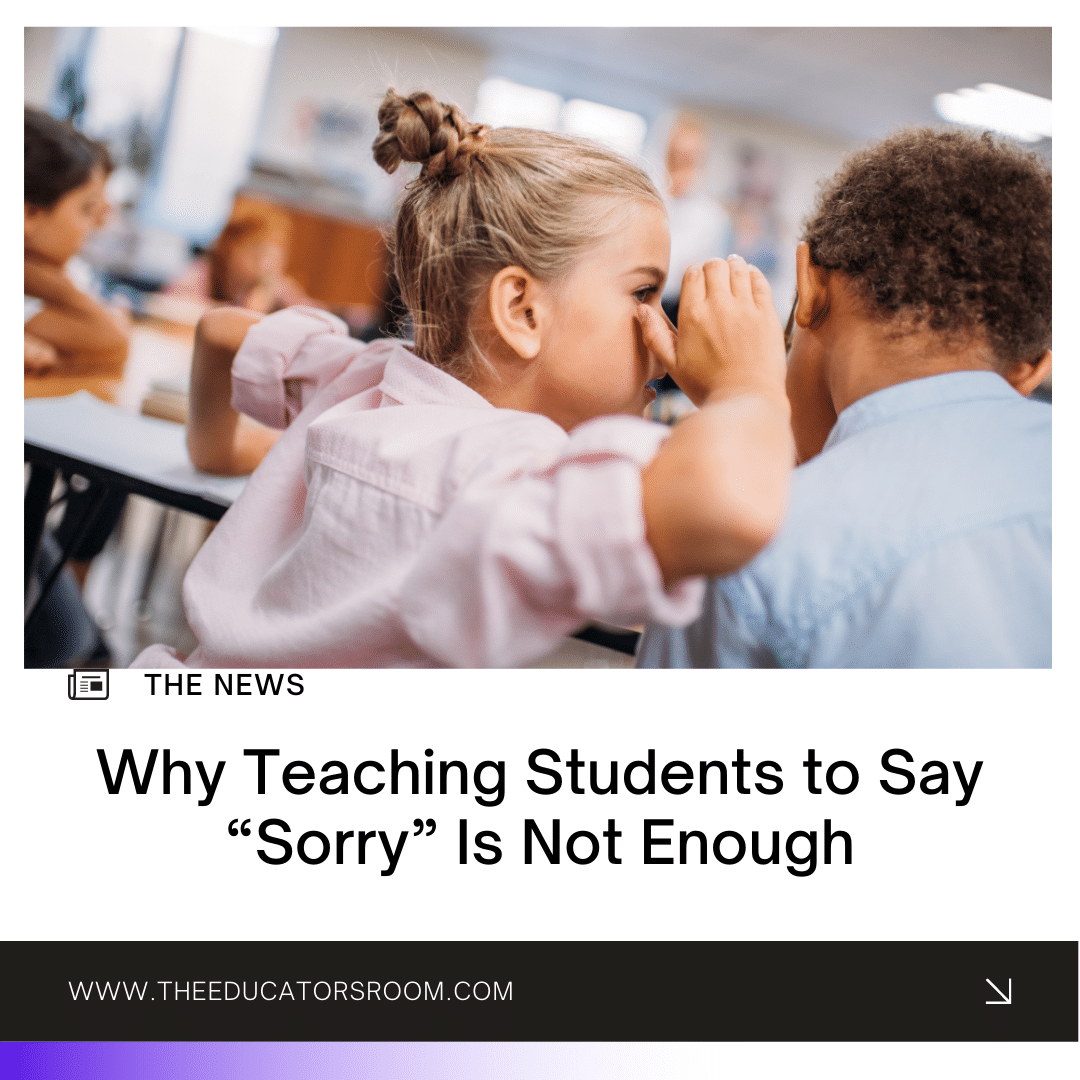You’re eight years old, and another student pushes you because they wanted to be first in line. Exasperated, your teacher tells the other child to say “sorry.” “Soooooory,” the child exclaims, rolling their eyes. “Say it like you mean it,” your teacher chides. “Sorry!” the other student yells a little more enthusiastically but still with little sincerity.
The Problem with the Traditional Approach
Sound familiar? At one point or another, we’ve all been on both sides of these interactions. We have been the educator, the child being told to apologize, and the student waiting for an apology. Worse yet, sometimes we’ve been told to apologize when we had done nothing wrong, to begin with! “They didn’t even say sorry” is a common phrase we hear in our classrooms, as students falsely believe they are owed an apology and that said the apology will make everything right. The thing is, in early childhood education, we know that much of the learning happens through making mistakes, and there are so many moments throughout the day when our learners will do something that they shouldn’t. It’s our job to teach them these skills so that as they grow, they will eventually make fewer of these mistakes. When we think about the most dysregulated students, the ones who struggle often, the ones who need the greatest amount of support, if we made those kids say they were sorry every time, they would be saying it all day long.
Challenging the ways we were taught, we no longer make students say they’re sorry.
Don’t get us wrong, saying sorry can be an important step in making amends, which is a skill that we do want our students to learn. We are not opposed to the word ‘sorry’; in fact, we are Canadians, so sorry is one of our most frequently used words! When we take a critical look at apologies, we’ve realized that expecting students to say “I’m sorry” and then move on quickly wasn’t exactly teaching our students the skills that we want them to learn.
So we’ve renegotiated our relationship with ‘I’m sorry.’
When we as adults and educators ask students to apologize, particularly to other students, we often hear an impatient, let-me-just-say-this-and-get-out-of-here kind of sorry. In fact, we have our own memories of adults asking us to apologize, and we said it begrudgingly when in fact, we were definitely not sorry. Apologies that start and end with the words “I’m sorry” can be quick and insincere. We also think about how busy and chaotic our learning spaces can be. Even the most observant educator can’t possibly see everything.
In situations where a student reports to us that something has happened, we might not have been there to witness it ourselves. When the story of one student offending another is presented to us, we don’t always know if we are hearing the whole truth. How can we make students apologize for something that we did not see? Yes, maybe student A did hit student B, but maybe student B kicked them first and then ran away before an educator noticed.
Does this mean that we don’t teach kids to apologize at all or that we never use the words “I’m sorry”? Definitely not. When we think about what we really want students to learn when harm is done, it gets much more intricate than just saying a couple of words, and then they’re home free. We want students to understand that their actions affect others. Whether it’s by accident (a student gets pushed by another student who is running past them) or on purpose (a student is making fun of someone else’s lunch), it is important that our students learn that their actions do have implications for those around them.
We also want our students to learn empathy, and that is a tall order for the 3-6-year-olds in our classrooms, never mind older students. We know that it will take a long time, with lots of modeling, and repeated opportunities to practice, in order for our students to build empathy skills.
What do apologies look like in our classrooms?
Like most things in life, there is no one size fits all template for an apology. Each situation will be unique, and you know your students best. Maybe there is a lagging skill that needs to be addressed, like learning to recognize the emotions of others or understanding the intentions of peers. Here are some practices we’ve found to be the most helpful when supporting students in apologizing sincerely:
Address the emotional and physical needs of both parties first
Students who are crying or hurt are not ready to apologize or to hear an apology. The same goes for a student who is hiding because they upset someone. The first step is to bring the students back to a state of calm so they are ready to hear the lesson you want to teach them. This may look like giving them some time, providing them with space, or sitting near them in a non-threatening way. Apologies do NOT need to happen right away.
Validate emotions
This is a tricky one. We don’t want to reinforce behavior, but we do want to validate the feeling that led to the behavior, then give students skills they can use the next time that emotion pops up. If a student knocked over another child’s tower, we might say, “I’m guessing you were feeling frustrated that they had more blocks than you. That’s really tough. Next time, come find me, and I can help you ask for more blocks to use.”. If you don’t know what they were feeling, ask! “I’m wondering what was going on?”. Building this rapport with students helps them see you as a teammate and an option in future situations.
Teach students how to apologize
Once a student is ready, we walk them through ways they can make amends. We give them the language they may need (“I’m sorry that I knocked over your tower. It won’t happen again.”). If possible, we have them try to repair the situation or relationship (“Can I help you rebuild?”, “What do you need to feel better?”). We value that there are many ways to apologize. The student may want to write a note, make a card, give the other student a calming tool, get them ice, invite them to play, or use their words. All forms of apologies are valid if they are sincere.
We provide support during the apology
This may be controversial, but sometimes we apologize on behalf of students who are not ready. This is typically the case when a student is feeling their shame deeply and maybe goes into a fight/flight/freeze response when faced with upsetting emotions. This sounds like, “I can tell by your body and your face that you really wish you had made a different choice. Would you like some help apologizing? I can say the words for you.”. Then, to the offended student, “(Name) is not ready to use their words yet, but I know they wish that they hadn’t done that. I’m going to apologize on their behalf and say sorry that happened, it won’t happen again.”. We find that after apologizing on behalf of a student, they are able to come out from their threatened state and eventually reach out to the offended student in their own way.
Teach students that not all apologies will be accepted (ever or right away)
Just because a student is ready to apologize doesn’t mean the offended student is ready to hear it. It’s also a skill to accept an apology and a learning opportunity when an apology is not accepted. It is the offended student’s right to want space and to need time to forgive another student’s actions. When an apology is not accepted, we may say something like, “You’ve done your best to show them you are sorry. They aren’t ready to accept your apology yet and they are allowed to be still frustrated. They may need more time to see that you won’t do it again. We will just have to be patient.”.
At the end of the day, some interactions don’t require apologies at all. Students have been so primed to say, “He/She didn’t even say sorry!” at any minor upset that they need to develop the skill of pushing past hurt feelings and continuing on with their day. This is another tough life lesson to learn- sometimes, you won’t get an apology at all.
If you have ever made students say sorry…
We get it! We grew up with this messaging too. We were made to apologize before we were ready or for things we didn’t do. This is a hard lesson to unlearn. If you are starting on this journey of teaching sincere apologies, be gentle with yourself. It takes practice.
Apologies are an incredibly personal thing, and despite what we were taught as children, they don’t need to happen right away. Sorry, not sorry.
Avery and Alannah are French Immersion Kindergarten Teachers in Ontario, Canada. With 16 years of teaching experience between them, they have been working to think critically about education and question the “traditional” ways of teaching. Avery solidified her love of the early years by becoming a Kindergarten specialist. Alannah chose to focus on early childhood education during her Master’s degree. In their spare time, they run the Instagram account @gentle.teachers where they share their learning about adopting a gentle approach to teaching young students.







